![]()
![]()
![]()
Use LEFT and RIGHT arrow keys to navigate between flashcards;
Use UP and DOWN arrow keys to flip the card;
H to show hint;
A reads text to speech;
42 Cards in this Set
- Front
- Back
- 3rd side (hint)
|
Plasma |
Transports things like CO2 from organs to the lungs, soluble products of digestion and the 3 other components of blood |
|
|
|
Red Blood Cells |
Bioconcave No nucleus Contains haemoglobin Carry oxygen |
|
|
|
White Blood Cells |
They form antibodies which engulf and produce antitoxins to kill the pathogens |
|
|
|
Platelets |
Broken pieces of Red Blood Cells Help the blood clot Fibrinogen changes into fibrin which clots the blood to form scabs |
|
|
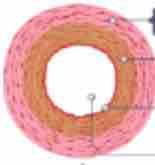
What is this? |
Artery Small Lumen , Thick layer of muscle + elastic fibres, thick wall Carry the blood away from the heart High pressure Muscles give strength and elastic fibres give it a high pressure as they spring back
|
|
|
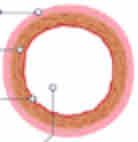
What is this? |
Vein Large lumen, valves, thin walls Carry blood towards the heart Heart valves prevent back flow Low pressure Large linen helps blood flow |
|
|

What is this? |
Capillary Single Cell thick walls, tiny vessel and barrow lumen Carry blood through organs Permeable walls to speed up diffusion Supply food and CO2 and get rid of waste i.e O2 |
|
|
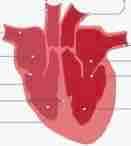
Label the height? |
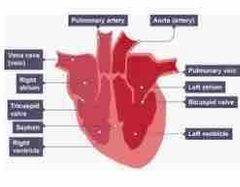
Vena Cava - Deoxygenated blood from around body goes into the heart Pulmonary Artery - Deoxygenated blood to the lungs Aorta - Oxygenated blood to the rest of the body Pulmonary vein - oxygenated blood from the lungs goes into the heart Valves -Prevent the back flow of blood Left is right, right is left Top right, left atrium Top left, right Atrium Bottom right, left ventricle Bottom left, right ventricle |
|
|
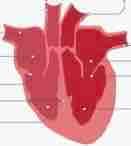
Label the heart |
Vena Cava - DeO2 blood from around body - heart Pulmonary Artery - DeO2 blood to the lungs Aorta - O2 blood to the rest of the body Pulmonary vein - O2 blood from the lungs - heart Left is right, right is left Atrium and Ventricle |
|
|
|
Double circulation |
Whether to transport system is pumping blood 1) blood from heart to lungs and back again 2) blood from heart rest of the body and back |
|
|
|
Coronary heart disease |
The heart gets oxygenated blood from the coronary arteries Coronary heart disease happens when the arteries get blocked due to fatty material building up |
|
|
|
Coronary heart disease |
The heart gets oxygenated blood from the coronary arteries Coronary heart disease happens when the arteries get blocked due to fatty material building up |
|
|
|
Stents |
Metronet which open up the arteries to allow blood to go through Done via open-heart procedure. Balloons blown over thin metal net which sticks it to the walls It stops the problem before it gets worse |
|
|
|
Statins |
Prescribe to the patient Pills that lower cholesterol This means that it reduces the fatty deposits in the arteries |
|
|
|
Animal valves |
Sometimes patients have a leaky valves, this means that blood flows in the wrong direction causing a heart attack Doctors can use animal valves instead. Requires an open heart procedure May go against some religions, such as Islam who can’t eat pigs |
|
|
|
Artificial pacemaker |
A pacemaker keeps the beat of the heart. The normal resting beat is 70bpm. Artificial pacemaker is electricity can be fitted They don’t last that long and it’s a malfunction take place the person made life |
|
|
|
Temporary hearts |
This can be either animal hearts or artificial electrical hearts These are good because they keep the patient alive while waiting for a heart transplant. However, the patient has to be on drugs to stop the blood from clotting. |
|
|
|
Ventilation |
Moving air in and out |
|
|
|
Trachea |
Rigid tube made out of Cartilage |
|
|
|
Lungs |
Spongy organs that filled with air when we inhale Situated in the thorax (the top half of the body.) |
|
|
|
Lungs |
Spongy organs that filled with air when we inhale Situated in the thorax (the top half of the body.) |
|
|
|
Alveoli |
Where gas exchange takes place, bronchioles carry air to them. They are surrounded by capillaries |
|
|

What does this show? |
Gas exchange: 1) Oxygen diffuses into the blood in the capillaries via the alveoli 2) Carbon dioxide diffuses out of the blood 3) Air is continuously moving in and out of the alveoli |
|
|
|
Adaptations of the alveoli |
- large surface area (big storage) - thin walls (shorter storage path) - good blood supply via the capillaries - steep concentration gradient - smile diffusion of oxygen and carbon dioxide |
|
|
|
Breathing in |
1) Intercostal muscles between ribs, contract, moving the rob cage up and out 2) Diaphragm muscles contract and the diaphragm flattens. 3) Volume of chest and thorax increases 4) Low pressure as air is drawn into the lungs |
|
|
|
Breathing out |
1) intercostal muscles between the ribs, relax, moving the rib cage down and in 2) The muscles of the diaphragm relax and the diaphragm becomes domes 3) Volume of the thorax and chest decreases 4) Pressure increases as air is forced out of the lungs |
|
|
|
Epidermis tissue |
Covers the plant |
Plant Tissue |
|
|
Palisade Mesophyll |
Many chloroplasts which contain chlorophyll which are important have photosynthesis |
Plant Tissue |
|
|
Spongy Mesophyll |
Air spaces to all gases to pass through Large surface area for diffusion of gases
|
Plant Tissues |
|
|
Xylem |
Transports water and dissolved minerals to the rest of the plants Water needed for Photosynthesis Water needed to support the cells, especially young plants and leaves |
Plant Tissues |
|
|
Phloem |
Transports dissolves food substances from the leaves to the rest of the plant Sugar needed for all cells Sugar needed for growth |
Plant Tissue |
|
|
Plant organs |
Stems, Roots and Leaves |
|
|
|
Meristems |
Found in the roots and shoots |
|
|
|
Leaves Water Loss |
1) Soil absorbers water and passes it up the plant to the leaves 2) In the leaves the air spaces mean that water vapour is lost. This is called transpiration. 3) This can be stopped by the the guard cells by closing the stomata.
|
|
|
|
Factors affecting the rates of Transpiration |
Temperature Humidity Air flow - Light Intensity |
|
|
|
Temperature |
As Temp increases molecules move faster which increases evaporation But as temp increases the rate of photosynthesis also increases |
|
|
|
Humidity |
Diffusion of water is faster in dryer air |
|
|
|
Air flow |
Wind flow increases the rate of evaporation, as it keeps a steep concentration gradient and blows away the water vapour |
|
|
|
Light Intensity |
More light = more photosynthesis = more stomata holes open = more evaporation |
|
|

What does this show? |
This shows a potometer. A potometer show the water uptake of a plant under different conditions |
|
|

What does this show? |
This shows a potometer. A potometer show the water uptake of a plant under different conditions |
|
|
|
How can plants control water loss |
- plants have a waxy, Waterproof cuticle - most of the stomata our on the underside of the leaf - wilting can reduce water loss, the leaves hand down decreasing the surface area - the stomata close to reduce water loss |
|

